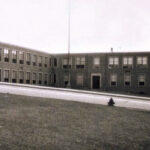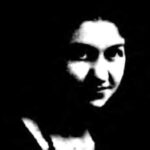Dubuque’s Irving School has a long history, dating back to 1866 when the school was known as the “West Dubuque School.” The original school, located on the corner of University Ave. and Irving St. across from where Westminster Church now stands, was constructed on land purchased from a Mr. Bush for $500. The school boasted two rooms, two teachers, and had a capacity of 120 students. Fifty-two students started the new school year in 1867.
On the evening of November 29, 1880, the school, a “barn-like structure” according to the Dubuque Daily Herald, burned to the ground. Students moved to a temporary location while a new school was built on the current site of Westminster Church. The teacher/student ratio in 1883 of 1 to 54 meant crowded classrooms and busy teachers. In 1884, slate blackboards, new innovations, were installed on a trial basis. On December 23, 1889, when the public schools were renamed, the West Dubuque School officially became known as Irving School.
Fire struck Irving School again on March 11, 1892, destroying the two-story building designed by George Thompson of New York. Firemen arriving by horse-drawn engines were hampered by a lack of water and drained the neighborhood cisterns before discovering the cistern on the school ground was filled. Although the school was a total loss, Principal Walsh was credited with leading all the children to safety.
G.S. Weaver completed construction on the third Irving School within a year, on the same location as the previous school, at a cost of $17,404. By 1924, the school had reached capacity, and an annex with four classrooms and a gym was added. An underground tunnel connected the main school building to the annex.
In 1949, 9.3 acres were purchased for a new school on Pennsylvania Ave., a site located outside the city limits at that time. By 1950, Dubuque’s population had grown to 50,000. The student body at Irving had grown to 374 students who were taught by 14 teachers. With the increase in population on Dubuque’s west side, the need for a new school became a necessity.
The cornerstone for the new, $600,000 elementary school was laid in 1951. Naming the new school was put to a vote. “Irving” won out over “Horace Mann” by a vote of 48 to 39 with “Anna B. Lawther” coming in a distant third with just 9 votes. The current Irving School was dedicated on October 28, 1953, with C. Freaman Reid as principal.
The former school site on University was sold to Westminster Presbyterian Church in July 1953 for $46,052. Crowds gathered to watch the massive, swinging, wrecking ball crash into the brick building and demolish the old school.
As Irving’s enrollment continued to increase, an addition was completed in 1961. Later, portable classrooms were added to accommodate the growing student body. The addition of an elevator in 2000 made the school completely accessible for the first time. Another addition in 2010 on the building’s south side added a Learning Resource Center, computer lab, and lunchroom.
In the mid 1950s, the innovative “released time” Christian Education program sponsored by the Dubuque Council of Churches came to Irving and Dubuque’s other eight public schools. Some 3,000 communities across the country took part in the program, but Dubuque was the first major city in Iowa to use it following the State Attorney General’s approval on August 18, 1953.
Approximately 700 third, fourth, and fifth graders participated in Dubuque’s Christian Education program. Classes were taught in a 36-foot mobile classroom outfitted with Formica-topped double desks and benches, a heater, books, and visual aid equipment. Weekly, hour-long classes were scheduled for each school.
The shiny aluminum trailer was parked on the street in front of the schools to the delight of school children, who looked forward to colorful, Christian education workbooks, the novelty of being taught in a “trailer,” and the temporary escape from the regular classroom. Mrs. Helen Streng, wife Rev. William Streng, Wartburg Theological Seminary professor, taught “trailer” classes at Irving.
Irving School has always boasted an excellent staff of teachers, but Miss Gladys Catherine Mougin was perhaps one of most tenured, most loved, and most admired. Born in Illinois on July 27, 1895, she was teaching primary children in Elizabeth, Illinois, by 1917. In 1925, Miss Mougin was hired to teach first grade at Irving School in Dubuque, replacing Miss Gertrude Smith.
Miss Mougin stood out among the female teachers at Irving. She towered above her young students, standing 5 feet 9 inches tall. She had dark brown hair and eyes with a prominent nose according to her 1922 passport application, which was filed before she sailed from New York to the “British Isles,” France, Belgium, German, Austria, Switzerland, and Italy for a summer of travel and education.
Miss Mougin taught hundreds of young, first grade Irving students to read and write. Students recall taking turns sounding out the alphabet one letter at a time as Miss Mougin moved up and down the rows of desks. Miss Mougin called the “th” combination “the gander sound” and imitated a hissing goose to emphasize the exact pronunciation, making the class giggle. With letter sounds mastered, the students eagerly read beginner books focusing on the adventures of Dick, Jane, Sally, and their pets Spot and Puff. They read through the green, red, and blue storybooks that featured Tom, Betty, Susan, and their dog Flip.
Following her retirement, Miss Mougin moved back to Elizabeth. She died on March 29, 1981, at the age of 85 as the result of a two-car accident. Irving alumnae mourned her passing, but fondly recalled those early days when she taught them the wonders of reading and writing – with a little arithmetic on the side.
This article is part of the Shades of Dubuque series, sponsored by Trappist Caskets, hand-made and blessed by the monks at New Melleray Abbey.








Comment here